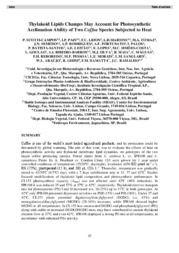Thylakoid lipids changes may account for photosynthetic acclimation ability of two coffea species subjected to heat.
Thylakoid lipids changes may account for photosynthetic acclimation ability of two coffea species subjected to heat.
Author(s): SCOTTI-CAMPOS, P.; PAIS, I. P.; LIDON, F. C.; MARTINS, L. A.; TOMAZ, M. A.; SEMEDO, J. N.; RODRIGUES, A. P.; FORTUNATO, A. S.; PALOS, I.; BATISTA-SANTOS, P.; LEITÃO, A. E.; LOPES, E.; SIMÕES-COSTA, M. C.; GOULÃO, L.; RIBEIRO-BARROS, A. I.; SILVA, M. J.; MAIA, R.; MÁGUAS, C.; REBOREDO, F. H.; PESSOA, M. F.; morais, l. e.; SANGLARD, L. M. V.; ARAÚJO, W. L.; GHINI, R.; DaMATTA, F. M.; RAMALHO, J. C.
Summary: Summary: Coffee is one of the world?s most traded agricultural products, and its production could be threatened by global warming. The aim of this work was to evaluate the effects of heat on photosynthetic activity and thylakoid membrane lipid dynamics, on genotypes of the two major coffee producing species. Potted plants from C. arabica L. cv. IPR108 and C. canephora Pierre Ex A. Froehner cv. Conilon Clone 153 were grown for 1 year under controlled conditions of temperature (25/20ºC, day/night), irradiance (650-800 ?mol m-2 s-1), RH (75%), photoperiod (12 h), and 380 ?L CO2 L-1. Thereafter, temperature was gradually raised to 42/34ºC (0.5ºC/ day), with a 7 days stabilization step at 31, 37 and 42ºC. Studies focused modifications of thylakoid lipid composition and photosynthetic performance. In CL153 photosynthetic capacity (Amax) was not affected until 42ºC (40% reduction). In IPR108 it was reduced 35 and 57% at 37ºC at 42ºC, respectively. Thylakoid electron transport rate for photosystems (PS) I and II increased (ca. 10-25%) up to 37ºC in both genotypes. At 42ºC only IPR108 presented depressed activities on PSII (15%) and PSI (18%). Under 37 and 42ºC, CL153 plants presented digalactosyldiacylglycerol (DGDG) (ca. 42%) and monogalactosyldiacylglycerol (MGDG) (28-34%) increases, while IPR108 showed higher MGDG at all temperatures. In CL153 less unsaturated DGDG and phosphatidylglycerol (PG) along with stable or increased DGDG/MGDG ratio, may have contributed to sustain thylakoid electron flow at 37ºC and even 42ºC. IPR108 displayed a strong PG rise at all temperatures, in accordance with enhanced PSs activity.
Publication year: 2014
Types of publication: Paper in annals and proceedings
Unit: Embrapa Environment
Keywords: Aclimatação, Café, Clima, Coffea arabica, Dióxido de carbono, Fotossíntese, Temperatura
Observation
Some of Embrapa's publications are published as ePub files. To read them, use or download one of the following free software options to your computer or mobile device. Android: Google Play Books; IOS: iBooks; Windows and Linux: Calibre.
Access other publications
Access the Agricultural Research Database (BDPA) to consult Embrapa's full library collection and records.
Visit Embrapa Bookstore to purchase books and other publications sold by Embrapa.

